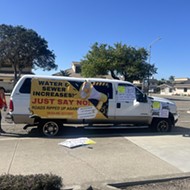[
{
"name": "Newsletter Promo",
"id": "NewsletterPromo",
"class": "inlineCenter",
"insertPoint": "4",
"component": "15264767",
"requiredCountToDisplay": "0"
},
{
"name": "Ad - Medium Rectangle CC01 - 300x250 - Inline Content",
"class": "inlineCenter",
"insertPoint": "8",
"component": "15582119",
"requiredCountToDisplay": "12"
},{
"name": "Ad - Medium Rectangle LC01 - 300x250 - Inline Content",
"class": "inlineCenter",
"insertPoint": "18",
"component": "15582122",
"requiredCountToDisplay": "22"
},{
"name": "Ad - Medium Rectangle 9 - 300x250 - Inline Content",
"class": "inlineCenter",
"insertPoint": "28",
"component": "15582121",
"requiredCountToDisplay": "32"
}]
Atascadero and its partners will have a new tool to assist them as they continue to address large homeless encampments in the city.
"The ordinance before you was written with the intent of dealing with camps and not the individuals," Atascadero City Manager Jim Lewis said at the Sept. 26 City Council meeting. "These camps are impacting public spaces. ... We need a tool to help us deal with this while working to provide spaces for people to [safely] park and stay."
The city had already been working with its Police Department, the El Camino Homeless Organization (ECHO), San Luis Obispo County, and mental health officials to help homeless individuals on a case-by-case basis.
"I just want to reiterate the stories of success I have heard and the compassion in which our teams are serving the unhoused population," Lewis said. "I love to hear about the success and that we are housing people that need a house."
Council voted unanimously to revise the city's 2013 camping ordinance to more specifically outline where camping was prohibited. This included banning encampments within 500 feet of government buildings, certain parks, underpasses, and riverbanks.
Atascadero Interim Police Chief Joe Allen said the city had to revise and clarify the parameters of the ordinance because it wasn't legally enforceable.
"The original ordinance prohibited camping on any public land in Atascadero," Allen said at the meeting. "The result of decisions that were made by several court cases, ballot measures, and state legislation ... made it so that ordinance was unable to be enforced, so we needed to change it."
Allen added that the ordinance was not intended to be enforced immediately or constantly but rather serve as a fail-safe.
"There is the letter of the law and the spirit of the law, and we want to be more in line with [the latter]," he said, explaining that it would only include out of compliance situations, such as large encampments with unsanitary or unsafe conditions or drug use.
Lewis echoed that sentiment, adding that the city would continue to collaborate with San Luis Obispo County, ECHO, and mental health teams to address individual cases beyond the ordinance.
However, not everyone on the council was interested in what they considered to be very broad and unclear enforcement areas.
"Some people might look at 500 feet and go, 'Is this our way of saying nowhere without actually saying nowhere?'" Councilmember Charles Bourbeau asked. "I just want to make sure this has been looked at under the seemingly limited guidance that has been left."
Councilmember Susan Funk questioned where homeless individuals could go, as the ordinance left only small pockets of space for them to legally live in.
"We need to make sure these people have places to go," she said. "I want us to be mindful as we look at this ... and make sure [the unhoused] have access to the tools that exist."
Allen reassured both Funk and Bourbeau that the updated ordinance would mainly serve as a tool for large, uncooperative public encampments.
"Our goal is to keep up what we are doing," he said at the meeting, "We are not ramping up enforcement—this is just a tool to replace the old tool that we cannot use anymore because it is invalid." Δ
Latest in News
Readers also liked…
-

SLO police identify alleged driver who hit and killed couple
Dec 22, 2022 -

When the levee breaks: Oceano residents, county officials walk a tightrope of regulations to manage Arroyo Grande Creek, which some say led to the levee's failure in January
May 18, 2023 -

Cal Poly report highlights offshore wind's potential to spur green energy transition
Jun 8, 2023









